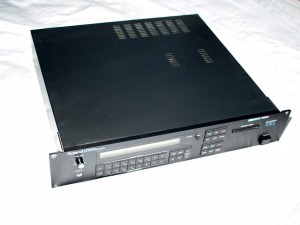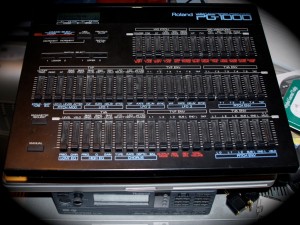Roland D-550 Synthesizer
This page is dedicated to the Roland D-550. What is the D-550? It is the rackmount version of the legendary Roland D-50 keyboard. I LOVE my D-550’s, I have two! There’s just something about their sound that to this day can’t be replicated, except by perhaps Roland’s own V-Synth which can be installed with a virtual D-50 add-in board.
[history & brethren gear @ synth-studio]: Roland MT-32, Roland D-110
[technical specs]
Synthesis Type: Marketed as “Linear Arithmetic”. In reality it is a “Sample and Synthesis” machine, with the capability to utilize short PCM samples of instrument attack sounds married to digital synthesis for the sustain of the sound. Additionally, it is considered to be one of the first “virtual analog” synthesizers by today’s standards. This is due to the fact that while it is an all “Digital Synthesis” machine, it is capable of producing very realistic analog style sounds reminiscent of the older Roland, Moog, Oberheim, and other analog synthesizers.
Polyphony: 32. However patches on the D-550 were made up of an “Upper Tone” and “Lower Tone”. These tones then consist of up to two “Partials”. Each Partial, uses one note of polyphony. So the effective polyphony of many patches on the synth was really only 8. However, it is also common for many patches to use only one tone, making the effective polyphony 16.
Effects: Yes. The D-550 has available 32 types of Reverb and 8 types of Chorus. It is, to my knowledge, the first synthesizer to ever have on-board effects processing of any kind. The D-550 is also the first synthesizer to employ “Ring Modulation”; various modes of ring-modulation can be configured at the tone level. Additionally, the “Chase Play” mode of the D-550, which allows the Lower Tone to be output at a delay after the Upper Tone, has been used in many patches for interesting effect, and sometimes as what I would call a faux arpeggiator.
[demo sounds]
Audio clip: Adobe Flash Player (version 9 or above) is required to play this audio clip. Download the latest version here. You also need to have JavaScript enabled in your browser.
[links]
 Comment Meta:
Comment Meta:RSS Feed for comments
TrackBack URI












 Pages
Pages  Categories
Categories  Tag Cloud
Tag Cloud  Entries RSS
Entries RSS  Seven
Seven  City
City  Characters
Characters  Landscape
Landscape  Nature
Nature  Shapes
Shapes ![[-]](https://www.synth-studio.com/blog/wp-content/themes/i7_0961/images/st_ar.png)
